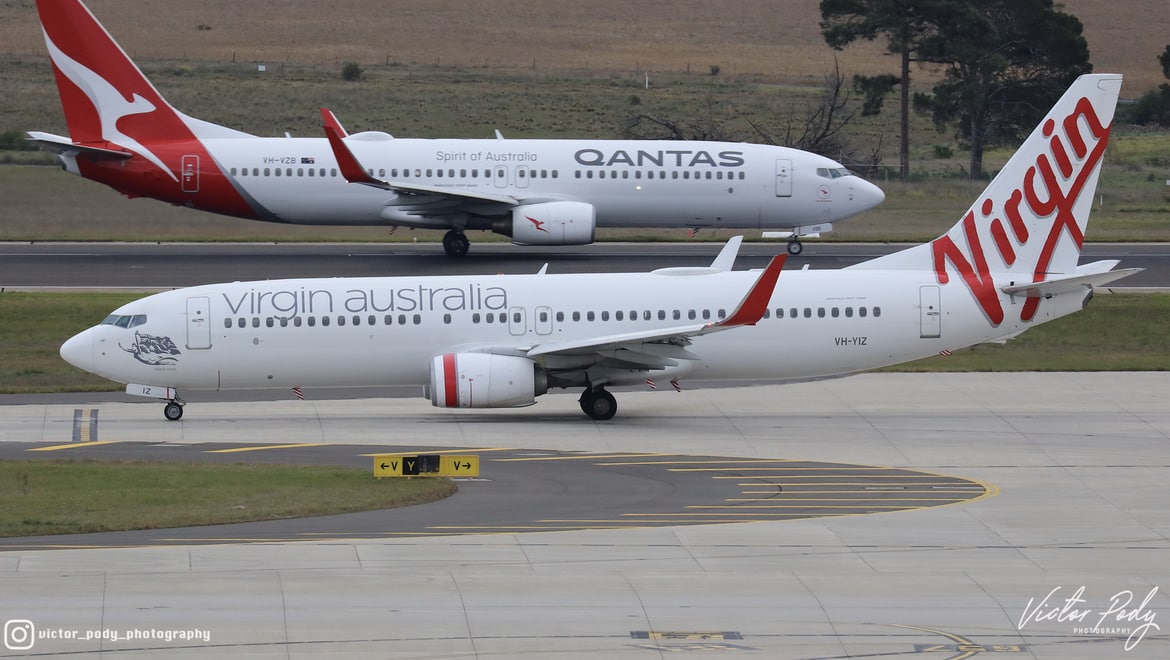
Qantas has overtaken Virgin to perform better on delays after months of it being the worst-performing airline in Australia.
New official figures back up recent claims by the national carrier and show that 69 per cent of its flights by Qantas and QantasLink arrived on time in September, compared to 68 per cent for Virgin and VARA combined.
The pair have been trading places on performance over the last year, with Virgin recently overtaking Qantas after the national carrier was ahead for eight of the past 12 months.
The good news comes after a year when the national carrier has faced a string of problems, including huge delays at Easter, hours-long call wait times, and even a revelation that the cabin crew of a Qantas A330 were made to sleep across seats in economy.
Across the industry, school holidays have led to the worst delays on record in April, June and July.
New BITRE data released on Monday by the Department of Transport show on-time performance across all major airlines averaged 68.3 per cent for on-time arrivals and 67.7 per cent for on-time departures.
That’s a huge improvement on the performance across Australia’s winter months but “significantly lower” than the long-term average for on-time arrivals on all routes (81.8 per cent) and on-time departures (83.0 per cent).
Rex is still the top-performing airline across both metrics, recording 75.1 per cent for departures and 73.3 per cent for arrivals.
The report read, “The Qantas network (Qantas and QantasLink combined operations) recorded 69.2 per cent for on-time arrivals while the Virgin Australia network (Virgin Australia and Virgin Australia Regional Airlines combined operations) recorded 68.2 per cent.
“Virgin Australia achieved the highest on-time arrivals among the major domestic airlines at 68.1 per cent, followed by Qantas at 66.1 per cent and Jetstar at 60.4 per cent.
“Of the regional airlines, Rex Airlines recorded 73.3 per cent for on-time arrivals, followed by QantasLink at 71.5 per cent and Virgin Australia Regional Airlines at 69.7 per cent.
The Qantas network recorded 69.0 per cent for on-time departures, while the Virgin Australia network recorded 66.7 per cent.
“Virgin Australia achieved the highest level of on-time departures among the major domestic airlines for September 2022 at 66.7 per cent, followed by Qantas at 65.1 per cent and Jetstar at 57.5 per cent.
“Of the regional airlines, Rex Airlines recorded 75.1 per cent for on time departures, followed by QantasLink at 71.9 per cent and Virgin Australia Regional Airlines at 67.6 per cent.
“Jetstar recorded the highest percentage of cancellations (at 9.5 per cent) during the month, followed by Virgin Australia Regional Airlines (at 4.6 per cent), Qantas (at 2.5 per cent), QantasLink (at 2.4 per cent), Rex Airlines (at 2.3 per cent) and Virgin Australia (at 1.9 per cent). Airlines’ on time performance varies across the routes they serve.”
Qantas said this month that its improvement was due to both keeping capacity in reserve for difficult periods and investing in training and recruiting staff.
In total, it said it would invest $200 million for the remainder of the financial year to roster additional crew, train new recruits and pay for overtime in contact centres.
It also said its new “conservative” approach to scheduling means 20 per cent of its available seats will be left in reserve.
“This includes up to 10 narrow-body, six wide-body and four regional aircraft on standby across Qantas and Jetstar,” said the business in a statement. “This capacity can be gradually added back as certainty improves, and the additional cost is expected to be similarly temporary.”
Qantas Group CEO Alan Joyce said, “Since August, we’ve seen a big improvement in our operational performance and an acceleration in our financial performance.
“It’s clear that maintaining our pre-COVID service levels requires a lot more operational buffer than it used to, especially when you consider the sick leave spikes and supply chain delays that the whole industry is dealing with.
“That means having more crew and more aircraft on standby and adjusting our flying schedule to help make that possible, until we’re confident that extra support is no longer needed.
“Qantas’ operations are largely back to the standards people expect, and Jetstar’s performance has improved significantly in the past few weeks and will keep getting better with the extra investments we’re making.”
The ACCC first revealed last month how domestic airlines had been significantly reducing capacity to mitigate the delays and cancellations caused by staff shortages and sickness.
The competition watchdog revealed the cut in seats for sale during the last few months came despite the local industry hitting 97 per cent of pre-pandemic passenger numbers in June.
It followed separate Cirium figures that showed Virgin, Qantas, and Air New Zealand were named among the global airlines with the current highest cancellation rates.















